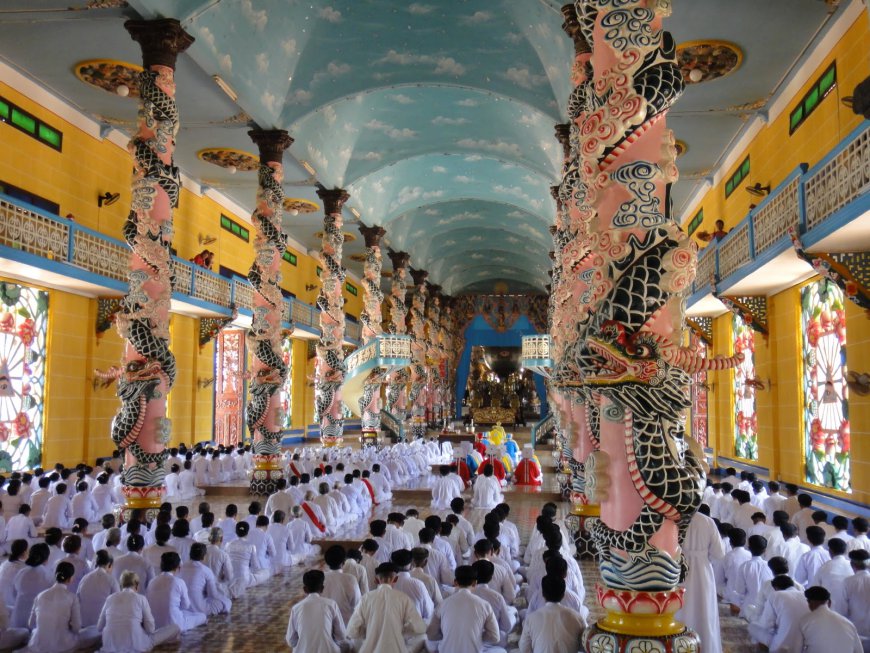Top 6 Religions in Vietnam and safety tips for traveler
Discover the top 6 religions in Vietnam, from Buddhism to Catholicism, and gain insights into their cultural significance. Learn essential safety tips for travelers to ensure a smooth and enriching experience while exploring Vietnam's diverse religious landscape.

Vietnam a Southeast Asian country with a rich cultural heritage is known for its religious diversity. Religion in Vietnam is a tapestry of indigenous beliefs and practices influenced by neighboring countries and colonial history. Here we explore the top six religions that shape the spiritual landscape of Vietnam providing insight into their origins beliefs and impact on Vietnamese society.
We are exploring some religions of Vietnam:
1. Buddhism
Origin and History: Buddhism is the most practiced religion in Vietnam with roots tracing back to the 2nd century AD when it was introduced by Indian traders and missionaries. It gained prominence during the Ly and Tran dynasties (11th-14th centuries) becoming the state religion and deeply influencing Vietnamese culture and philosophy.
Cultural Impact: Buddhist temples and pagodas are ubiquitous in Vietnam serving as spiritual hubs and cultural landmarks. Iconic sites like the One Pillar Pagoda in Hanoi and the Perfume Pagoda in Ha Tay attract pilgrims and tourists alike. Buddhism's emphasis on compassion and mindfulness permeates Vietnamese social values and daily life.
2. Catholicism
Origin and History: Catholicism was introduced to Vietnam in the 16th century by Portuguese missionaries and later expanded by French colonialists. Despite periods of persecution it established a significant presence especially in the northern and central regions.
Cultural Impact: Catholicism has influenced Vietnamese education and healthcare with many schools and hospitals established by Catholic orders. Architecturally stunning churches such as Notre-Dame Cathedral in Ho Chi Minh City are prominent features of urban landscapes. Catholic festivals often blend local traditions creating unique expressions of faith.
3. Cao Dai
Origin and History: Cao Dai is a syncretic religion founded in 1926 in Tay Ninh Province. It combines elements of Buddhism Taoism Confucianism Christianity and Islam reflecting Vietnam's religious pluralism. Cao Dai was established by Ngo Van Chieu who claimed to have received a vision of the Supreme Being.
Cultural Impact: The Cao Dai Holy See in Tay Ninh is an architectural marvel attracting visitors with its colorful eclectic design. Cao Dai's inclusive philosophy fosters religious tolerance and dialogue in Vietnam. The religion's emphasis on community service and ethical living resonates with broader Vietnamese cultural values.
4. Protestantism
Origin and History: Protestantism arrived in Vietnam in the early 20th century through American and European missionaries. It has grown steadily particularly among ethnic minority groups in the Central Highlands and northern regions.
Cultural Impact: Protestant communities contribute to social development through educational and healthcare initiatives. Their emphasis on community and mutual support strengthens social cohesion. Protestant churches often simple in design are hubs of religious and social activity particularly in rural areas.
5. Hoa Hao
Origin and History: Hoa Hao Buddhism is a modern Buddhist sect founded in 1939 by Huynh Phu So in the Mekong Delta region. It emerged as a reform movement emphasizing simplicity and social equality.
Cultural Impact: Hoa Hao's principles of modesty and communal welfare have significantly impacted rural communities in the Mekong Delta. The religion's emphasis on education and social reform has contributed to regional development. Hoa Hao temples serve as centers for both worship and community activities.
6. Indigenous Religions
Cultural Impact: Indigenous religions play a crucial role in preserving the cultural identities of Vietnam's ethnic minorities. They are integral to community life influencing social structures art and oral traditions. Festivals like the Lunar New Year and local harvest celebrations are imbued with spiritual significance.
Vietnam Safe to Travel
Vietnam with its breathtaking landscapes rich history and vibrant culture has become a top destination for travelers worldwide. But is Vietnam safe to travel The short answer is yes but let's delve into the details to ensure you have a smooth and safe journey.
Safety in Vietnam: An Overview
1. General Safety
2. Common Scams
3. Traffic and Road Safety
Staying Safe in Vietnam: Tips for Travelers
1. Stay Alert in Crowded Areas
2. Use Reputable Transportation
3. Respect Local Customs
4. Secure Your Valuables
Emergency Contacts in Vietnam
Police: 113
Fire: 114
Ambulance: 115
Vietnam is a fantastic destination that offers a blend of natural beauty historical richness and cultural vibrancy. While it is generally safe being mindful of your surroundings and taking basic precautions will ensure a safe and enjoyable trip. Happy travels.
Conclusion
Vietnam's religious landscape is a rich mosaic of beliefs and practices reflecting the country's historical and cultural diversity. Buddhism Catholicism Cao Dai Protestantism Hoa Hao and indigenous religions each contribute to the spiritual and cultural fabric of Vietnamese society. This pluralism fosters a climate of religious tolerance and mutual respect enhancing Vietnam's cultural richness and social harmony. Vietnam is a fantastic destination that offers a blend of natural beauty historical richness and cultural vibrancy. While it is generally safe being mindful of your surroundings and taking basic precautions will ensure a safe and enjoyable trip. Happy travels! Understanding these religions offers valuable insights into the values traditions and way of life in Vietnam highlighting the intricate interplay between faith and culture. As Vietnam continues to evolve its religious heritage remains a vital aspect of its national identity shaping both individual lives and communal bonds.
